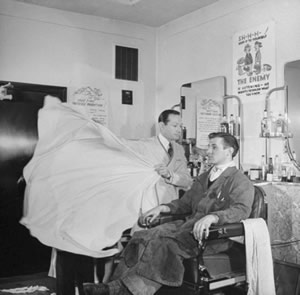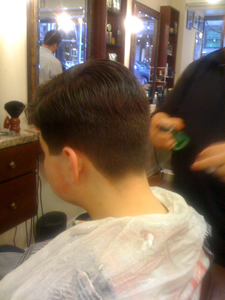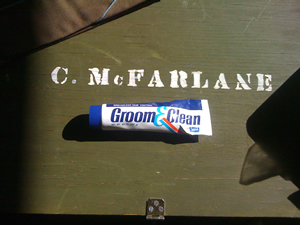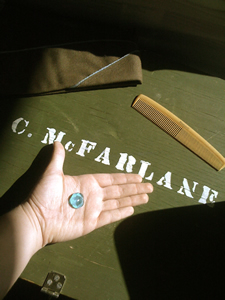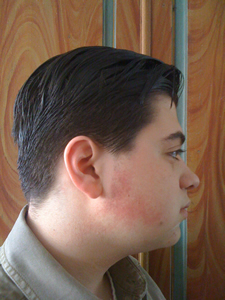GI Hairstyles: Original Images, Observations and Recommendations
Date Written: Winter 2010
Author: Charles McFarlane - 90th IDPG
Editor: Chris Guska - 90th IDPG
Foreword:
We're switching authors at this point - to someone with a bit more hair to experiment with than the author of the prior pages.
As discussed on the preceding introduction and analysis, there are several period correct hairstyles that you can attempt. Finding the right barber or stylist and the right haircut that fits you well can be an ongoing exercise. Charles (author of the below text and star of the photos) has the luxury of an "old fashioned" barber who grew up with and has spent his entire life in the trade. Charles' notes, photographs and instructions detail the longer "hollywood" style haircuts as observed and illustrated on previous pages.
Visiting your barber:
One of the most important things to ask your barber is for a tapered cut on the back of the neck. Block cuts, the other alternative to a tapered cut, on the back of the neck is a more modern style. What a tapered back of the neck is that instead of using a razor across the neck making a “block” line, the barber uses the razor following the natural hair line on the neck “tapering” to a point. Your taper should end above your collar of your shirt, and should be no higher then the bottom of the your ears.
As you can tell from photos used in this article, the men’s hair of the 1940’s was universally short on the sides, keeping above the ears. Some modern barbers have a hard time achieving this, either over doing it, creating a 50’s style “white wall”, or under doing it by not clearing hair from the arch.. What you want to ask your barber for is a taper. A taper on the sides basically means that with shears and a razor your barber blends the top of your head’s hair with the side,
My own hair demonstrating the “taper” on the sides.
The Last thing you should keep in mind is the top of your hair can be long, anywhere from eyebrow length to nose length. This is totally acceptable, but you must make sure to watch the volume of hair, as it may need to be thinned to lay properly. Your barber can do this with thinning shears and scissors.
Hair Products:
Now that you have the 1940’s haircut you now need to know how to look the part. In the 1940’s a man’s hair was always combed be it going to the movies with a date or to get a pack of Luckies from the newspaper stand. There were four common ways to comb the hair, parted on the left, parted on the right, parted down the center, or no part at all just swept back. In Today’s culture hair that shines is a sign of grease or sweat, in the 1940’s is was the exact opposite, it was the sign of a clean well-groomed man. For men to get the shine and the hold needed to groom their hair they used products like pomade, hair tonic, and brylcreem. Most of these products are still available at pharmacy. Some of my favorite heritage and modern products are:
To do your hair in the 1940’s fashion you will need one or more of the products above, a comb , and a brush (note: depending on your hair you may be able to get by with out a brush)
Using Product:
The following is a step by step process on how to get that great 40’s look to go with the rest of your uniform.
First you want to have your hair moderately damp. If you are using Brylcreem or Groom and Clean you should squeeze about a quarter sized drop of the product mixed in both hands, if you are using a pomade a good two finger dollop mixed in the palms of your hands should be good.Then massage the product you are using into your hair with your hands. Using a comb, sweep your hair back. If you are going for the no part then you are good, you may want to use your brush on your sides and back. If you are going for the parted styles part your hair with your comb and still using the comb sweep the parted hair back still keeping the hair parted. Finally use the brush on your sides and back to follow the top hair back.
Closing Thoughts:
This concludes the “What to ask your barber?” section. Some other good tips to get a good 1940’s look would be to bring in a period picture; one from this article would be great, to the barber to show them. Enjoy, and stay away from the “High and Tight” or "HOOAH!"
An additional special thanks to my barber,
Jerry Picasso
Gents, New York
Barbershop
1183 Lexington Ave.
New York NY 10028
1.) Defining Terms and Styles
2.) Analysis and Conclusions
3.) What to ask your barber (You are here)
A.) The images
90th IDPG Original Research



